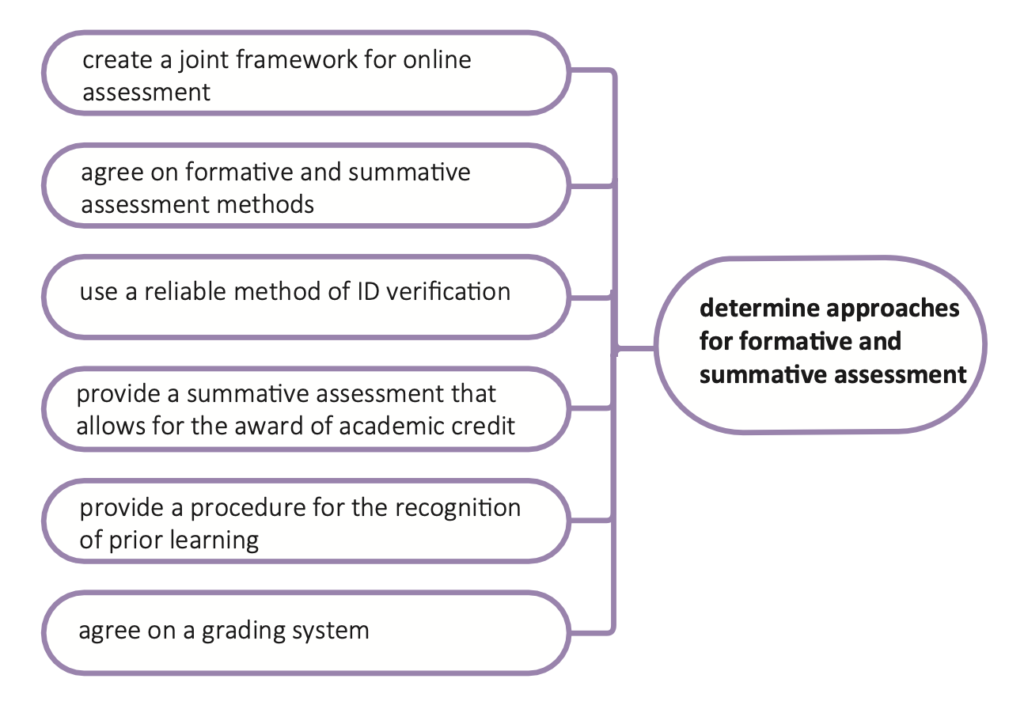
| The course team develops joint formative and summative assessment approaches: |
| Create a joint framework for online assessment; |
| Agree on formative and summative assessment methods; |
| Use a reliable method of ID verification at the assessment point; |
| Provide a summative assessment that allows for the award of academic credit through course completion; |
| Provide a procedure for the recognition of prior learning in case a micro-credential course didn’t lead to an academic credit; |
| Agree on a grading system. |
Guidelines
Create a joint framework for online assessment
Recently, an EADTU Special Interest Group has shared expertise on institutional strategies and experiences on online assessment (Rossade, Janssen, Wood & Ubachs, 2022). It first made an inventory of assessment practices and problems faced due to COVID-19. Further, it discussed about forward looking developments in online assessment including the recommendations of the TESLA project (TESLA, 2019). It examined research and innovation on online assessment and discussed also about institutional strategies, including examples from practice as well as national policies and frameworks.
Main themes in the report are about assessment design, trust and ethics, operational processes and the assessment future. It is useful that the joint course team reflects on some of these aspects and builds its own practical framework. See also: https://online-assessment.eadtu.eu.
Within such framework, some minimum requirements must be agreed. Here follow some basic guidelines.
Agree on formative and summative assessment methods
During the course, formative assessment is organized to support learning and to adapt or differentiate education. Common forms of formative assessment in online learning are quizzes, self-assessment, peer assessment, and learning agendas for practicing learning. For all these modes, giving feedback is important.
Learning analytics supports the formative assessment of online learners by the collection and analysis of data for the purpose of understanding and improving learning outcomes (Lang, C., Siemens, G., Wise, A., Gasevic, D., 2017; Solar, Society for Learning Analytics Research, 2022).
Regarding summative assessment, it is important that students know the exam criteria and exam methods for a course in advance, so that they can tailor their learning to the learning outcomes and competences they need to achieve through the course.
The way in which the exams are taken is in principle determined when the course is designed. In many micro-credential courses, summative assessment is organized at the end of a course unit after completion of successive formative assessments.
Partners should agree on a joint examination method to assess learner performance, including solutions for identity verification and proctoring exams. Latest developments are discussed in the TESLA project (TESLA, 2019) and the Special Interest Group mentioned above.
Seek support for assessment methods in the teaching and learning services.
Use a reliable method of ID verification at the assessment point
The assessment method is in accordance with the policies of the partner universities or widely adopted across the universities (more than one method may be used) (Iniesto, 2021).
Examples are:
- platform/LMS ID verification: match the student’s own photo via a selfie or a webcam with an ID;
- university registration: students complete a registration process within the university as undergraduate students;
- interview: conduct an interview on the university grounds (oral exams on site)
- conduct a short online interview to verify the student’s identity and work (online interviews)
- record a presentation as part of a capstone project 1 (recorded presentations)
The ID verification method has been checked as accessible for participants with accessibility needs.
Provide a summative assessment that allows for the award of academic credit
Typical approaches are (Iniesto, 2021):
- computer-based assessment: these assessments can be a final proctored exam, or quizzes based on case studies and coding projects2;
- teacher assessment: teacher assessments are often observed on essays and capstone projects;
- multiple-type rating: mix of computerized assessment and teacher-graded assessment
Provide a procedure for the recognition of prior learning in case a micro-credential course didn’t lead to an academic credit
This assessment must be conducted by a recognized university for the purpose of identifying, assessing and formally recognizing past learning and achievements, which are taken into account when a student is admitted to a formal qualification. According to the ECTS Users’ Guide, full authority for this recognition is given to university institutions. They will apply the procedures as laid down in the ECTS User Guide. This procedure identifies, documents and formally assesses a previous learning experience, which can then be certified and lead to partial or full qualification.
Agree on a grading system
European universities are likely to use different grading scales, for example 1-20; 1-10; 1-5 or 1-30. In some countries, almost a binary pass-fail system is used without further distinction. Performance on these different rating scales is often difficult to compare and can complicate the transfer of records as the programme team must agree on awarding a final grade or certificate to each student.
It is important that partners choose a common rating scale for the course (preferably the scale of the leading university, for example 1-20). Individual universities can use a transcription table in case they want to use these grades in wider programmes or for adoption in institutional data bases.
1. A capstone project is a culminating assignment, on which students usually work at the end of the academic course or programme, eg an essay, research paper or thesis.
2. Coding projects are one of the many ways you can learn the coding skills for programming.
next chapter: Assure quality
previous chapter: Agree on assigning an award
back to overview: Models and guidelines for the design and development of
joint micro-credential courses and microlearning units in higher education
